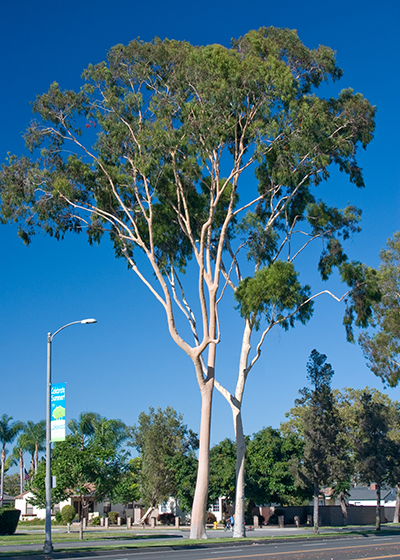
Eucalyptus globulus, blue gum eucalyptus, is a tree that is not native to California. It is an invasive plant that was introduced from Australia and naturalized in the wild. The California Invasive Plant Council (CAL-IPC) classifies the most common blue gum eucalyptus as a moderate invasive because the trees need certain conditions to thrive.
All eucalyptus species are prone to fire, and should be removed or require significant maintenance within 100′ of structures to reduce wildfire hazards.
California. In the 1850s, Eucalyptus trees were introduced to California by Australians during the California Gold Rush. Much of California has a similar climate to parts of Australia. By the early 1900s, thousands of acres of eucalypts were planted with the encouragement of the state government. It was hoped that they would provide a renewable source of timber for construction, furniture making and railroad ties. It was soon found that for the latter purpose eucalyptus was particularly unsuitable, as the ties made from eucalyptus had a tendency to twist while drying, and the dried ties were so tough that it was nearly impossible to hammer rail spikes into them.
One way in which the eucalyptus, mainly the blue gum E. globulus, proved valuable in California was in providing windbreaks for highways, orange groves, and other farms in the mostly treeless central part of the state. They are also admired as shade and ornamental trees in many cities and gardens.
Eucalyptus plantations in California have been criticised because they compete with native plants and do not support native animals. Fire is also a problem. The 1991 Oakland Hills firestorm which destroyed almost 3,000 homes and killed 25 people was partly fuelled by large numbers of eucalypts close to the houses.
Eucalyptus trees are not recommended due to their fire prone nature. Consider removing fir trees within 100′ of structures or 15′ of roadways. If a tree must be maintained in the defensible space zone (within 100′ of structures), extreme care should be taken to reduce the associated wildfire hazard.
Remove all limbs within 10′ of the ground, or 1/3 the height of the tree if less than 30′ tall
Remove all dead wood, peeling bark, and twiggy growth regularly
Provide canopy separation so that no limbs touch nearby trees or plants
Remove all “ladder fuels







